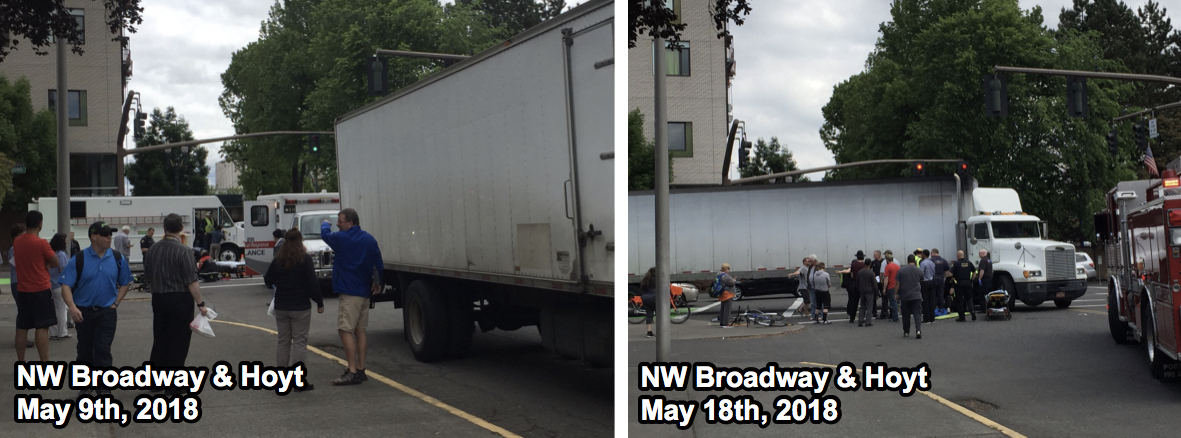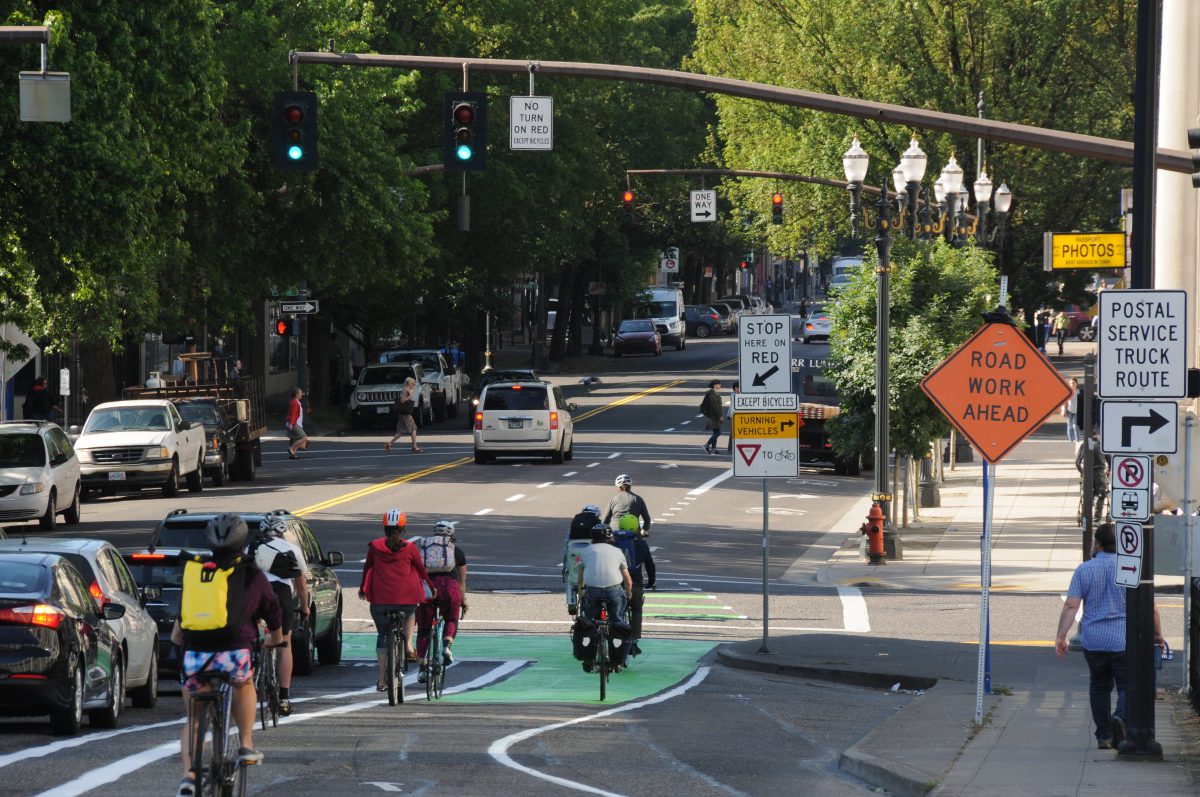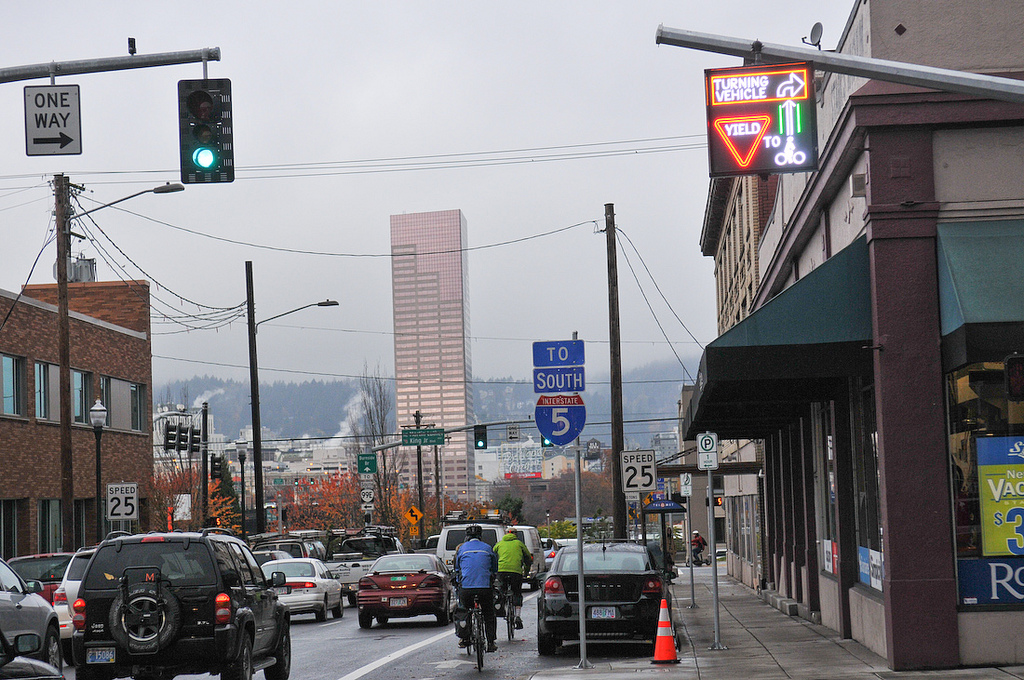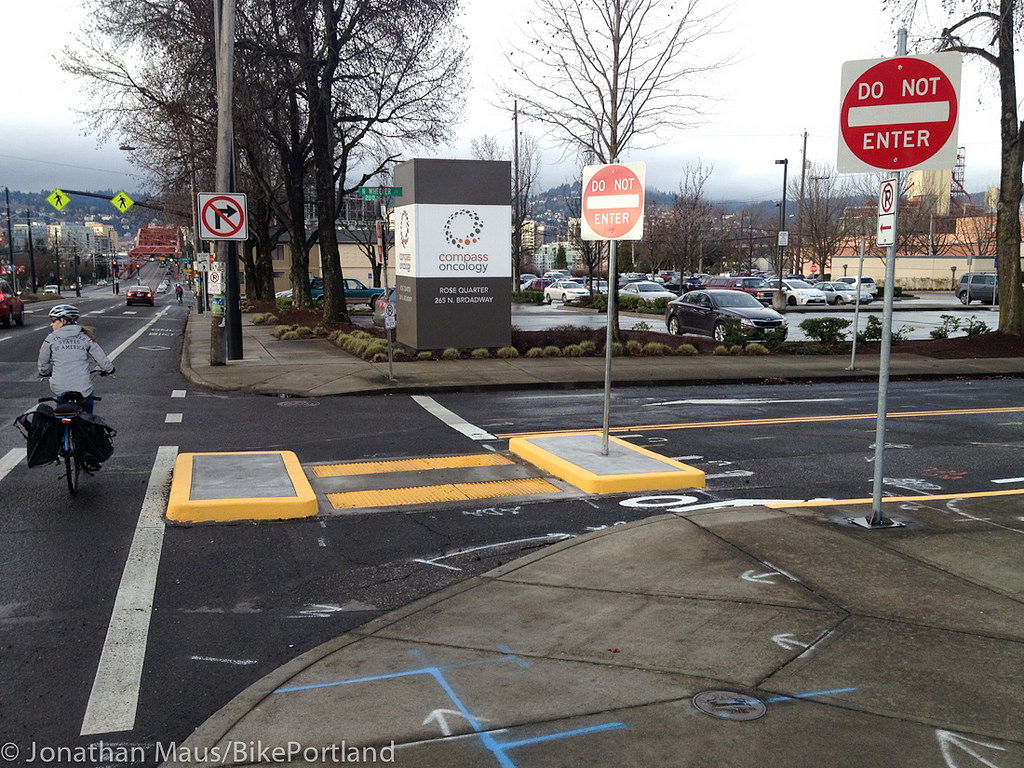
(Photos via @SmplicityCycles via Twitter)
It’s disheartening to start writing a post about the need for changes at a dangerous intersection only to recall that I already wrote the story. Nearly five years ago.
“Another right-hook at Broadway and Hoyt: What can we do about this intersection?,” screamed the headline in our October 2013 post.
And here we are today with the same concerns, the same problems and the same intersection.
“The cop who wrote the report said I was the 4th accident at that intersection past month.”
— Michael Rosenberg
In the past two weeks we have confirmed at least two serious injury right-hooks at Broadway and Hoyt. On May 9th, Michael Rosenberg was involved in a collision at Hoyt while biking down Broadway. He shared with us via email that, “A truck turned right in front of me.” Rosenberg also claims he tried to stop but skidded under the driver’s rear-wheel. He broke his pelvis in three places, fractured seven ribs, and fractured his spine. “The cop who wrote the report said I was the 4th accident at that intersection past month,” he added.
Then this past Friday May 18th, another person was involved in a right-hook collision with a truck operator at the exact same location. The victim in that crash suffered a broken collarbone and is on the mend.
Another similarity in these collisions is that the truck operator worked for the same company: Vancouver, Washington-based Dill’s Star Route Inc. That company is a (somewhat controversial) private contractor for the U.S. Postal Service, which runs a post office and mail distribution hub on the adjacent block. You can see another one of their trucks turning right on Hoyt in this short video I made this morning:
As we’ve chronicled too many times in the past, there are many reasons why Broadway and Hoyt is one of the most dangerous intersections for cycling in Portland: It’s on a downhill and most bicycle riders approach it at very high speeds; Hoyt is an official and signed truck route that experiences a high volume of right turns by large trucks; there’s a high volume of bicycle riders that go straight; and there’s zero protection for bicycle riders on a green signal phase.
(Let’s remember that road design is not solely to blame here. If people operated their vehicles more slowly, carefully, and with more respect for other road users, it’s very likely that none of these collisions would have occurred. But until we change our current road culture, we must change the environment that informs it.)
The City of Portland knows very well the dangers that lurk here. In 2007, following the deaths of Tracey Sparling and Brett Jarolimek via right-hooks by large truck operators, the Portland Bureau of Transportation included Broadway and Hoyt on their list of 14 intersections that would receive emergency funding and an innovative safety treatment: a bike box. It was intended to be filled with green color; but because bike boxes were still experimental at the time, the Federal Highway Administration required PBOT to keep it un-colored and to use it as a guinea pig in an experiment to see if color really influenced safety. In part because of that FHWA experiment, the bike box at Broadway and Hoyt remained uncolored.
Until May 9th.
The very first day the green paint went in, Michael Rosenberg was nearly killed in a collision. And nine days later, another person was hit under nearly identical circumstances. If nothing changes — or if we sit back and wait for the standard Portland pace of incremental changes — I’m afraid they won’t be the last.
Advertisement
PBOT’s 2017 bike counts tallied 2,835 average daily bicycle trips at Hoyt and Broadway, making it the third busiest biking intersection in the central city. All that bike traffic helped persuade PBOT to change the street design in 2013 by adding wider, buffered bike lanes on Broadway in the block approaching Hoyt. These lanes allow people on bikes to easily pass each other and offer a greater sense of safety — both of which might actually increase biking speeds and the risks of right-hooks at the intersection.


(Photos: Jonathan Maus)
Reached today for comment on the intersection, PBOT public information officer Dylan Rivera confirmed that Broadway is the street with the highest crash rate for bicycles in all of Portland.
Yet even with that knowledge — and a demonstrated risk to the bicycling public since at least 2007 — nothing significant has been done to protect road users. Only paint and signs have been installed.
“The signage and striping at the intersection is now up to our current standards.”
— Dylan Rivera, PBOT
“As a high crash network street, we are constantly seeing what safety improvements we can make in the short term, as well as developing plans for larger scale improvements that would require more time to implement,” Rivera wrote via email. “We continue to monitor the situation to see what other improvements might be possible there, and how crash patterns may change in the coming months.” It wasn’t clear if Rivera was aware of the two collisions that have happened since the latest changes were made.
“Studies from across the nation indicate we can expect a 39 percent reduction in bike crashes after installing green paint as we did May 9 at this location,” Rivera continued. “The signage and striping at the intersection is now up to our current standards.”
Rivera then pointed me in the direction of two potential projects that might help this intersection. An online open house that launches June 4th for the Central City in Motion project will include an option for a protected bike lane on Broadway. And an unfunded project on PBOT’s Vision Zero Project List would, “Enhance the existing bikeway on Broadway from Hoyt to Clay,” and, “Includes the construction of a protected bikeway, signal improvements, short-term parking and loading zones, and shorter pedestrian crossings.”
It’s unclear what impact, if any, those projects (if they ever happen) would have on reducing the risk of right-hooks at Broadway and Hoyt.
But we can’t wait. Signs and paint are not enough.
Is it time to prohibit right turns here?
I’m not an engineer, but in the past when we’ve had lives at risk from repeated right-hooks and a demonstrated trend of collisions, we’ve done something more significant about it.




(Photos: Jonathan Maus)
With support from the Portland Water Bureau (that prohibited its truck drivers from turning there) and in the face of strong opposition from a local business owner, former Mayor Sam Adams oversaw the prohibition of right turns from Broadway to Wheeler in 2012 and from Interstate to Greeley in 2009. Like Broadway and Hoyt, those right turns were on downhills and had a tragic history of right-hooks by truck operators. They remain closed to this day and everyone is safer because of it.
Absent something as bold as closing Hoyt completely to right-turning cars and trucks, perhaps we need a bike-only signal phase like we installed at Broadway and Williams in 2010? Or maybe it’s time to try one of those flashing signs that PBOT installed at Couch and Grand in 2011.
Something must be done. Broadway is the worst street for cycling in Portland. It’s also (arguably) the most important street for cycling in Portland. We must do more.
— Jonathan Maus: (503) 706-8804, @jonathan_maus on Twitter and jonathan@bikeportland.org
Never miss a story. Sign-up for the daily BP Headlines email.
BikePortland needs your support.


